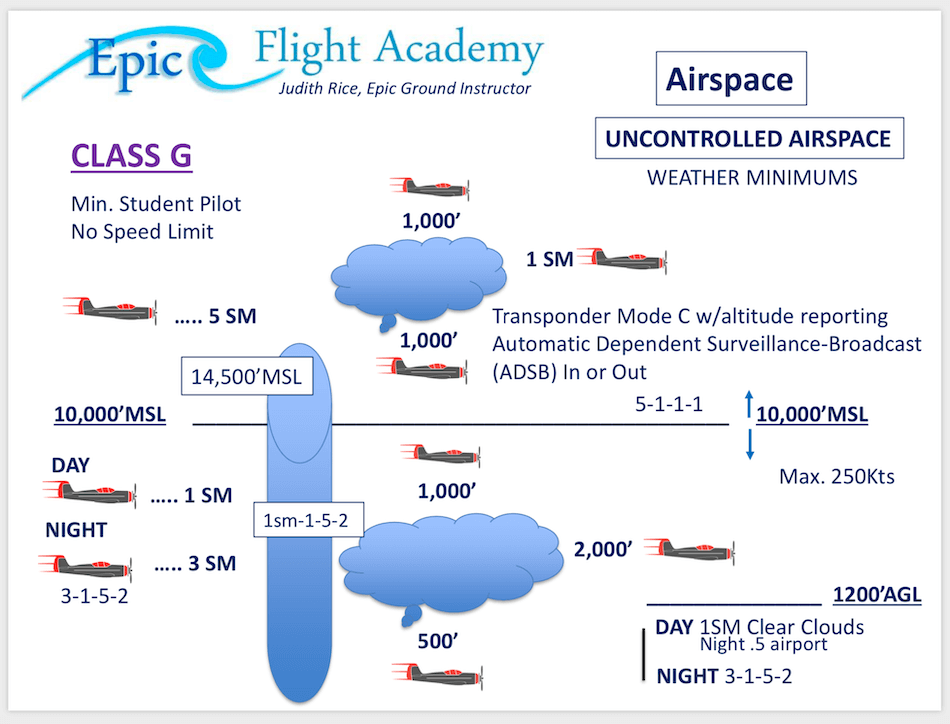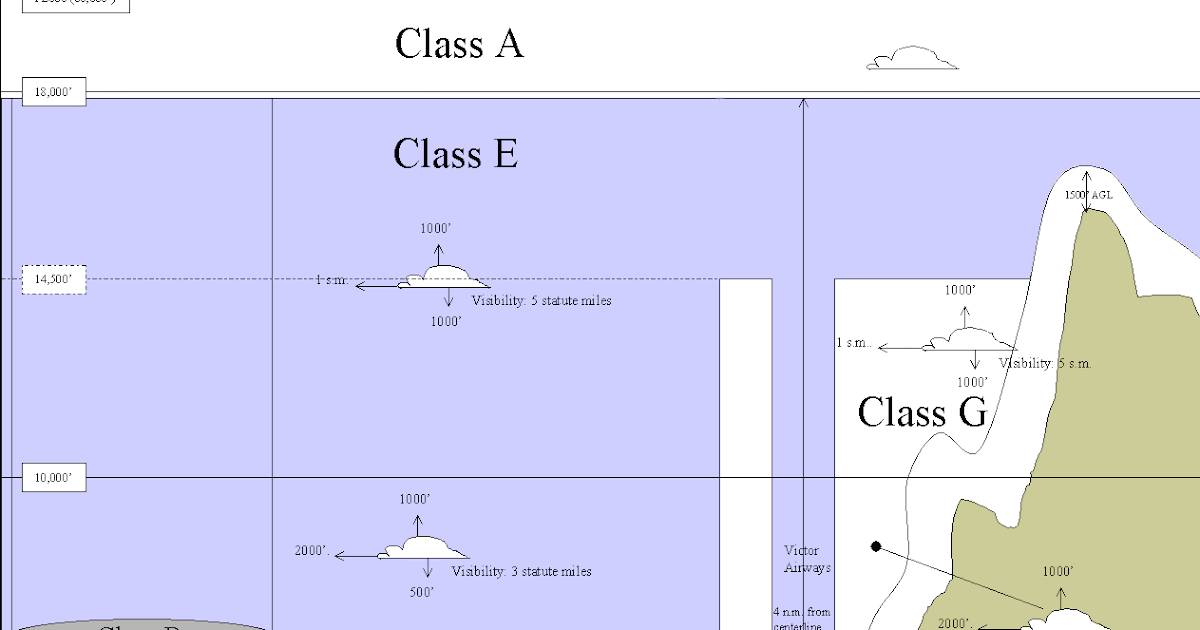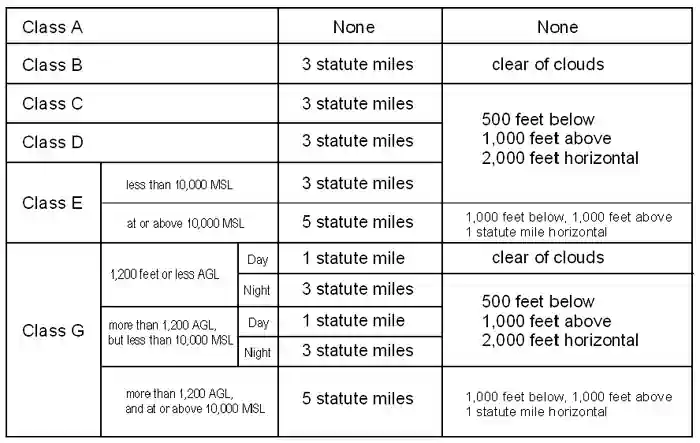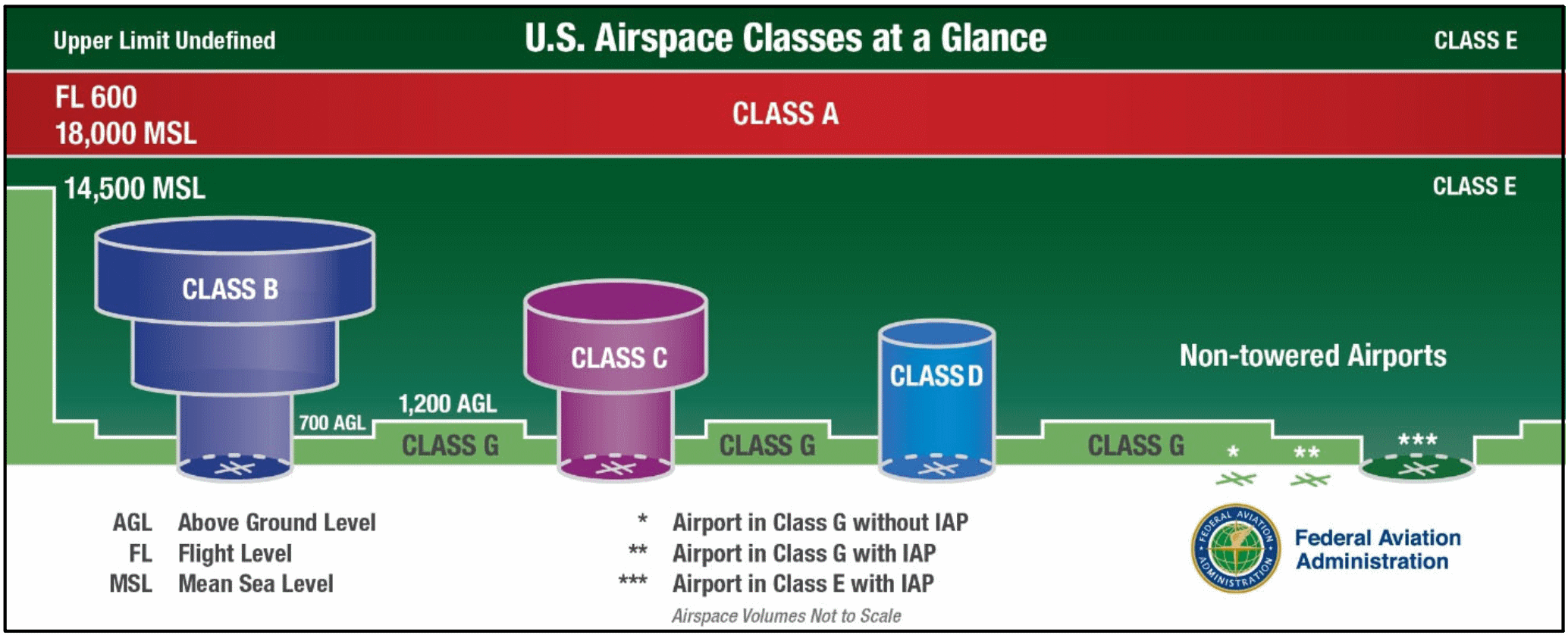class g airspace visibility requirements
A Unless otherwise specified in the certificate holders operations specifications when conducting VFR helicopter air ambulance operations in Class G airspace the weather minimums in the following table apply. During the day less than 1200 AGL in class G airspace the flight visibility requirements are ½ statue mile and the cloud clearance requirements are to remain clear of clouds.
There are a few nuances here so pay attention.

. In the airspace highlighted below Class E starts at 1200 AGL so Class G automatically starts at the surface and extends to - but doesnt include - 1200 AGL. 1200ft or less above the surface regardless of MSL altitude Day. AIP ENR has the requirement of flight visibility for operating at or above 10000 feet at or above 10 000 feet different requirements are in place regarding the minimum flight visibility for aircraft flying under visual conditions see AlP ENR.
A helicopter may be operated clear of clouds in an airport traffic pattern within 12 mile of the runway or helipad of intended landing if the flight visibility is not less than 12 statute mile. Distance from clouds requirement Clear of clouds. Visibility requirement 1 statute mile.
One mile visibility and clear of clouds is the daytime requirement. At night requirements jump to three miles visibility and from merely clear of clouds to 500 feet below 2000 feet horizontal and. Operating Rules and PilotEquipment Requirements.
Rules governing VFR flight have been adopted to assist the pilot in meeting the responsibility to see and avoid other aircraft. Daytime requirements for Class G are 1 statute mile visibility and clear of clouds to 1200ft. 1200 ft AGL or Below Night.
At night in Class G between 1200 AGL and 10000ft MSL the visibility and cloud clearance are the same as Class CD. Related Article Class G Airspace Explained. In Class B airspace aircraft are required to remain.
1200 feet or less above the surface regardless of MSL altitude For aircraft other than helicopters. You can remember Class G uncontrolled airspace because its just like the good old days at the dawn of aviation. 14 rows These minimums cover most Class G airspace but are only valid during the daytime.
Air Traffic Control Facility. There is no formal separation is provided so each pilot is. Class G airspace uncontrolled is that portion of airspace that has not been designated as Class A Class B Class C Class D or Class E airspace.
Visibility requirement 3 statute miles. Night except as provided in 91155 b 3 statute miles. The requirements are slightly less restrictive in Class G airspace with a less restrictive daytime visibility below 10000 feet MSL 1 statute mile only and below 1200 feet AGL by day a less-restrictive separation from clouds clear of clouds with no distance-from-cloud requirements.
Visibility and cloud clearance requirements are less as well like in class G airspace. 135609 VFR ceiling and visibility requirements for Class G airspace. Class A A for high Altitude or class alpha airspace exists from 18000 feet MSL up to 60000 feet MSL.
Above the Class G ground is Class E everywhere else and is controlled airspace. For aircraft other. Class G 1200 feet or less above the surface regardless of MSL altitude.
12 rows 1200 feet or less above the surface regardless of MSL altitude 1 statute mile. Class G airspace is more prevalent and may be found at lower altitudes in less dense areas of the country where IFR operations are less common. VFR Minimum Visibility Below 10000 MSL.
1200 ft AGL or Below Day. 1 statute mile visibility and clear of clouds. Above 10000ft MSL the requirements are 5 SM visibility and cloud clearance of 1000ft above 1000ft below and 1 SM horizontally.
On the other hand Class G airspace has four different sets of altitude-dependent minimums. At night less than 1200 AGL in Class G airspace the helicopter flight visibility requirements are 1 statue mile visibility and cloud clearance. June 4 2021.
Although Class G is uncontrolled it is also subject to the most weather restrictions based on where the airspace is located. Above 1200ft stays at 1sm visibility but then for cloud clearance you must be 1000ft above 500ft below and 2000ft horizontal. Class G Uncontrolled Class G is considered uncontrolled airspace but still has VFR weather minimums.
G night 3 statute miles 152 4500 below 41000 above 42000 horizontal G day 1 statute mile. Weather Requirements Class G minimum weather requirements exist so that you can see and avoid other aircraft and stay out of the clouds. 36 rows Notwithstanding the provisions of paragraph a of this section the following operations may be conducted in Class G airspace below 1200 feet above the surface.
Minimum flight visibility and distance from clouds required for VFR flight are contained in 14. August 16 2018 by ETL. Class G airspace is usually found below 1200 feet where Class E airspace typically starts although there are of course exceptions.
1200 or less above the surface regardless of MSL altitude Flight Visibility. Class G airspace is not depicted on any chart. When flying into an airport in Class G airspace communications should be established prior to 4 NM from the airport up to and including 2500 AGL.
Class G Airspace Weather Visibility Requirements. To fly in Class G airspace you will need a minimum of a student pilot certificate. Read More Airways System Airspace and Flight Services.
Day except as provided in 91155 b 1 statute mile. Posted June 16 2014. In accordance with FAR 91155.
Only IFR aircraft are permitted in class A airspace and air traffic control is responsible for ensuring their separation both vertically and horizontally. Currently helicopters operating in Class G airspace under VFR and less than 1200 feet above the surface are required by 91155 1 to remain clear of clouds and to operate at a speed that gives the pilot adequate opportunity to see any air traffic or obstruction in time to avoid a collision.

Vfr Cloud Clearances Pilot Training For Ga

Uncontrolled And Controlled Airspace

Airspace Classes And Special Use Airspace Everything There Is To Know

The Iconoclastic Aviators Blog Flight Under Visual Flight Rules Vfr In Class A Airspace Is It Legal
How To Remember Vfr Weather Minimums Bobbie Lind

Airspace Classes Explained The Ultimate Guide For Beginners

Faa Airspace For Vfr Flight Youtube
How To Remember Vfr Weather Minimums Bobbie Lind
Regulations Vfr Minimums Learn To Fly Blog Asa Aviation Supplies Academics Inc
How To Remember Vfr Weather Minimums Bobbie Lind

Uncontrolled And Controlled Airspace

This Is How Class G Airspace Works Boldmethod
What Is The Minimum Visibility For Landing Quora
Maintenance And Aircraft Mechanics Maintenance And Aircraft Mechanics Maintenance And Aircraft Mechanics Hot Air Balloon Hot Air Balloon Hot Air Balloon Aviation Training Handbooks Read Online Aviation Training Handbooks Read Online Aviation


